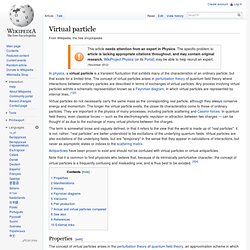

The Casimir Effect. Casimir effect. Casimir forces on parallel plates A water wave analogue of the Casimir effect.

Two parallel plates are submerged into colored water contained in a sonicator. When the sonicator is turned on, waves are excited imitating vacuum fluctuations; as a result, the plates attract to each other. The typical example is of two uncharged metallic plates in a vacuum, placed a few nanometers apart. In a classical description, the lack of an external field also means that there is no field between the plates, and no force would be measured between them.[1] When this field is instead studied using the QED vacuum of quantum electrodynamics, it is seen that the plates do affect the virtual photons which constitute the field, and generate a net force[2]—either an attraction or a repulsion depending on the specific arrangement of the two plates.
Virtual particle. In physics, a virtual particle is a transient fluctuation that exhibits many of the characteristics of an ordinary particle, but that exists for a limited time.

The concept of virtual particles arises in perturbation theory of quantum field theory where interactions between ordinary particles are described in terms of exchanges of virtual particles. Any process involving virtual particles admits a schematic representation known as a Feynman diagram, in which virtual particles are represented by internal lines. [1][2] Virtual particles do not necessarily carry the same mass as the corresponding real particle, although they always conserve energy and momentum. The longer the virtual particle exists, the closer its characteristics come to those of ordinary particles. They are important in the physics of many processes, including particle scattering and Casimir forces.